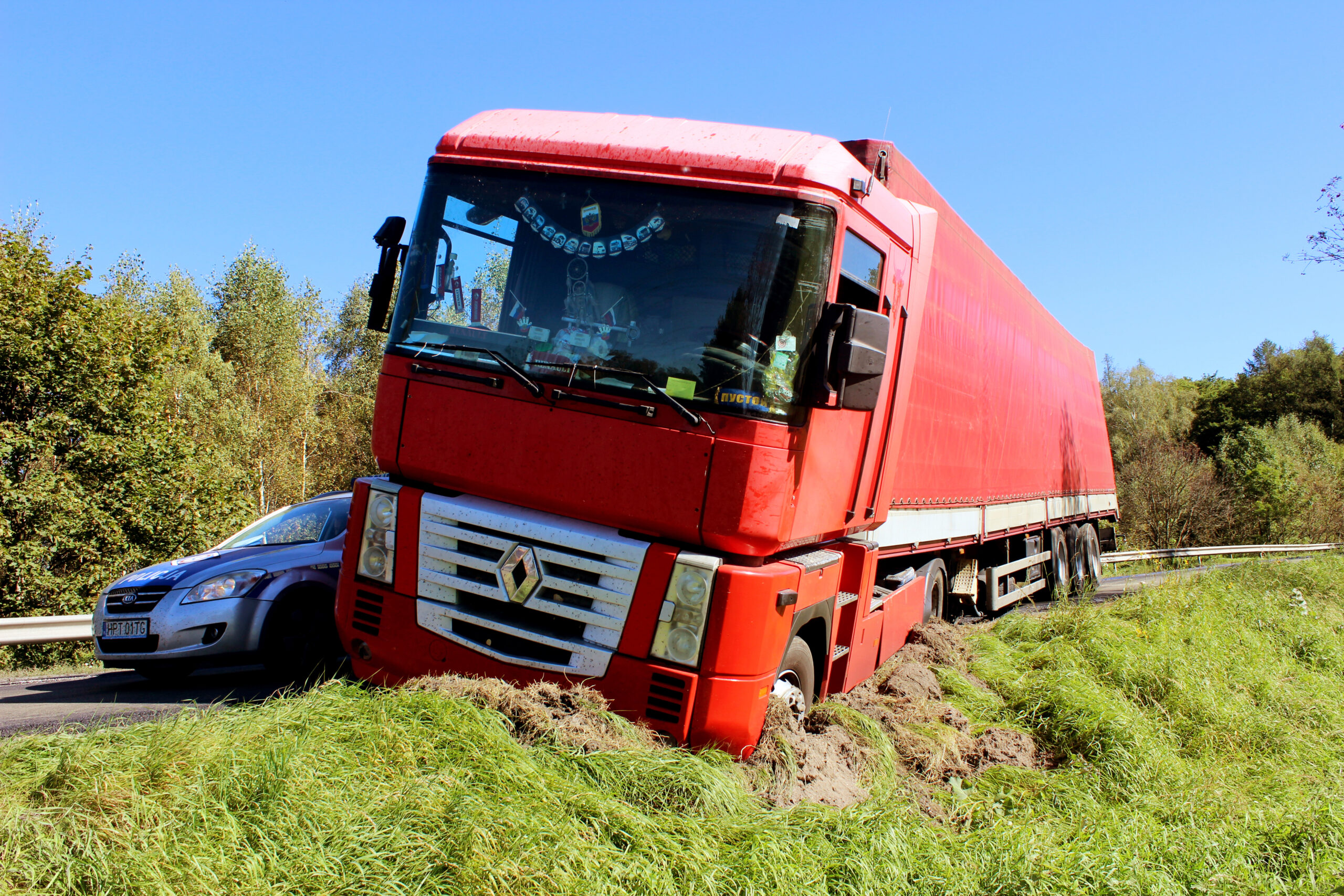Many accidents involving tractor-trailers, semi-trucks, 18-wheelers, and other large trucks occur when truck driver fails to check their blind spots. All truckers must exercise due care when operating a truck to avoid colliding with passenger cars, other trucks, motorcycles, bicycles, and pedestrians.
Truck accidents are not an uncommon occurrence on our roads. In a recent year, over 4,100 people died in collisions involving large trucks across the United States, according to the Insurance Institute for Highway Safety (IIHS). Occupants of passenger vehicles accounted for 67 percent of those fatalities.
Car drivers should know about a truck’s blind spots, known as no-zones when sharing the road with trucks. This can help avoid preventable crashes. Unfortunately, truckers can cause preventable accidents if they don't check their blind spot accidents.
When someone suffers injuries in an accident that occurred due to a trucker’s failure to adequately monitor their blind spots, the injured victim may be entitled to financial compensation. If this happens to you, contact a Phoenix truck accident attorney immediately for an evaluation of your rights.
Where Are the Truck Blind Spots?
Blind spots refer to areas around a vehicle where a driver loses sight of other vehicles. When a vehicle is lingering in a truck’s blind spots, the truck driver cannot see it when checking their side mirrors.
According to the Federal Motor Carrier Safety Administration (FMCSA), trucks have blind spots on all four sides:
- In front of the truck. A blind zone of about 20 feet extends beyond the hood in front of the truck, preventing the trucker from seeing what is happening directly in front of them. A rear-end accident is likely to occur if a truck driver cannot see your car in front of their vehicle, especially if the truck is not following a safe distance.
- The driver’s side. The left-hand blind spot is smaller than the right-hand no-zone. However, it can still extend back to approximately one-third or half of the length of the trailer. If someone is lingering in this blind spot and the truck driver decides to merge into the left lane, a crash will likely occur.
- The passenger’s side. The no-zone on the truck’s right-hand side can be quite large, extending several lanes from the front of the vehicle to the rear of the trailer. This blind zone extends backward diagonally at a width of three lanes. If a car is lingering in the right-hand blind spot or is trying to pass the truck on the right, a collision is likely to occur if the truck driver changes lanes or makes a wide right turn.
- Behind the truck or trailer. Since trucks do not have rear-view mirrors inside the cab, truckers have no visibility for about 30 feet behind the truck or trailer. If other vehicles fail to keep a safe distance behind the truck, a rear-end or underride accident is likely to occur.
As a rule of thumb, if you cannot see your reflection in the truck’s side-view mirrors, you are in the truck’s blind spot and are invisible to the trucker.
The Dangers of Truck Blind Spots
While all vehicles have blind spots, trucks have massive no-zones due to their length and height. Because of the size of the truck, certain parts of the road are invisible to truck drivers.
Often, a truck driver cannot prevent a blind spot accident by checking side-view mirrors alone. A trucker may be required to look over their shoulder before performing dangerous maneuvers such as changing lanes, turning, or passing.
While it may not be possible to avoid entering a truck’s blind spots at all times, it is vital to understand when you are in those no-zones to avoid lingering for too long and make yourself as visible as possible.
If you remain invisible to a truck driver or linger in a blind spot for too long, the truck driver may not be aware of your presence near the truck and may crash into you when switching lanes or turning.
When a truck accident occurs because a trucker fails to properly clear their blind spots before maneuvering the truck, the injured victim can seek compensation for their injuries, property damage, and other losses. The help of a skilled lawyer may be necessary to hold the trucker and other liable parties, including the driver’s employer, responsible for the collision.
Causes of Truck Blind Spot Accidents
While truck blind spot accidents can occur for various reasons, a large percentage of such crashes occur due to driver error.
The most common causes of truck accidents involving blind spots include:
- Failing to maintain a safe distance
- Driving recklessly or aggressively
- Failing to signal lane changes or turns
- Exceeding the posted speed limit
- Cutting off other vehicles
- Failing to pay attention to the road
- Driving while fatigued or drowsy
- Driving while impaired by alcohol or drugs
Truck drivers are responsible for a large percentage of blind spot truck crashes.
An injured party may hold a trucker liable for the accident if the truck driver:
- Drove under the influence of alcohol or drugs
- Failed to check their side mirrors and look over their shoulder to clear blind spots before performing dangerous maneuvers
- Lacked the necessary training or qualifications to drive large trucks
- Failed to keep a proper lookout for vehicles around the truck
- Failed to properly align the side mirrors to reduce no-zones
- Got distracted by their cell phones or other mobile devices while operating a truck
- Drove while fatigued, tired, or drowsy
- Exceeded the speed limit or drove too fast for weather or road conditions
- Violated federal trucking regulations
Often, a thorough and detailed investigation is necessary to determine fault in a truck accident.
Common Types of Truck Blind Spot Accidents
Truck accidents caused by a trucker’s failure to monitor blind spots can result in different types of crashes, including:
- Rear-end collisions. This type of accident can occur when a truck rear-ends a vehicle in front of it or another vehicle collides with a truck from the rear. These accidents are common when a trucker fails to see a vehicle directly in front of them or behind the truck or trailer.
- Sideswipe accidents. These collisions are likely to happen when another vehicle is trying to pass a truck on the left or right side, and the trucker decides to change lanes or turn.
- Side-impact accidents. These crashes are also known as T-bone collisions. A side-impact accident occurs when a vehicle lingers in the truck’s side blind spot and then swerves into the front blind spot. As a result, the truck strikes the side of another vehicle.
- Underride accidents. Underride crashes happen when a smaller vehicle gets crushed under the side or rear of a truck. A passenger car is likely to slide underneath the truck when the car lingers in the blind spot behind the truck or trailer.
According to the IIHS, a study showed that underride crashes accounted for about half of all fatal truck accidents.
Who Is Liable for Truck Blind Spot Accidents?
There may be multiple liable ties when truck accidents occur due to a trucker’s failure or inability to see other vehicles in the blind spots. In many cases, the truck driver is the only at-fault party when their negligence results in a preventable crash. However, a truck driver is not the only party that can be liable for a truck blind spot accident.
Liable parties may include:
- The truck driver might be responsible for causing a crash if they failed to exercise due care when operating the truck. Common examples of a trucker’s negligence include failure to check side mirrors before maneuvering, driving while distracted by a cell phone, and speeding.
- Other drivers. Truck drivers are not 100 percent at fault when collisions happen as a result of other vehicles lingering in the truck’s blind spots. For example, if another driver fails to maintain a safe distance, cuts off the truck, or otherwise fails to share the road with a truck with due care, the driver might be responsible for causing a collision. If that truck then crashes into your vehicle, you can seek compensation from the third driver, as well.
- The truck driver’s employer (the trucking company). If a truck driver was driving in the course and scope of employment when the truck blind spot accident occurred, the injured party can file a claim against the trucking company that employed the trucker. For example, the truck driver’s employer can be liable if they were negligent in hiring the driver or failed to provide proper training to the employee.
- The owner or manufacturer of the vehicle. If a collision was the result of a mechanical failure or defect, the injured party can potentially sue the owner or manufacturer of the vehicle. Vehicle owners must inspect and maintain their vehicles to prevent mechanical failures, while manufacturers can be liable when an accident occurs due to any defects of the vehicle.
- A government entity. If road design or poor road conditions contributed to a trucking accident, the injured party can pursue a lawsuit against the government entity responsible for road maintenance. For example, if a truck driver makes an unexpected lane change to avoid hitting a pothole but does not notice a vehicle in his blind spots, you might hold the government entity accountable for negligent road maintenance.
A knowledgeable lawyer can conduct a detailed investigation of the facts of your blind spot truck accident to determine fault and identify all liable parties.
Frequently Asked Questions (FAQs) About Truck Blind Spot Accidents
What Are the Most Dangerous Roads for Truck Accidents in Phoenix and Arizona?
Arizona has some dangerous roads that semi-truck, tractor-trailers, 18-wheelers, and other large trucks regularly use.
A large percentage of truck accidents occur on:
- U.S. Highway 93
- State Highway 87
- State Route 64
- Interstate 40
- Interstate 60
- Interstate 17
- Interstate 10
According to the National Safety Council, Arizona accounts for only 6.4 percent of total large trucks involved in fatal accidents.
What Compensation Can You Receive After a Truck Blind Spot Accident?
If you suffered injuries in a truck blind spot accident—or any other accidents involving large trucks, for that matter—you are likely facing astronomical medical bills and dealing with other financial, physical, and emotional damages and losses. As a victim of a truck crash, you can seek compensation by pursuing a personal injury claim through an insurance company or filing a lawsuit against the at-fault party.
Depending on the severity of your injuries and the complexity of your case, you might receive compensation for the following damages:
- Medical bills
- Lost wages
- Diminished or loss of earning capacity
- Physical pain and suffering
- Emotional pain and suffering and other emotional effects
- Disfigurement
- Permanent scarring
- Loss of companionship
- Property damage
- Loss of enjoyment of life
These and other losses may be compensable depending on the circumstances of your truck accident case. Consider contacting an experienced attorney to investigate your particular case and determine what damages you can recover in your situation.
How to Prove Negligence in a Truck Accident Case?
Another party is negligent if they fail to exercise reasonable care when operating a motor vehicle and someone sustains injuries as a result of that negligence. However, proving negligence can be tricky, especially if you do not have enough evidence to prove that the other party failed to use reasonable care.
What Evidence Do You Need to Prove Negligence?
You need to gather all available evidence to prove that the other party was negligent.
Evidence that can help you prove the other party’s negligence after a truck accident includes:
- A police report
- The trucker’s logbook
- The driver’s cell phone records
- The driver’s driving records
- Witness statements
- Photos from the scene of the accident
- Video footage showing the moment of the crash
- Testimony of expert witnesses
If you suspect that a truck blind spot accident occurred because of a trucker’s negligence, consider speaking with a lawyer to help you investigate what caused the crash and collect evidence proving the truck driver’s fault.
Why Do You Need a Skilled Phoenix Truck Accident Lawyer?

If you suffered injuries in a truck accident, consider speaking with a knowledgeable lawyer to help you establish fault, determine the value of your case, gather evidence, negotiate with insurance companies, and fight for maximum compensation in your case. Proving that a truck driver failed to adequately monitor their blind spots can be tricky, which is why having a skilled Phoenix truck accident attorney on your side can be beneficial for the outcome of your case.



